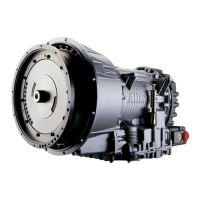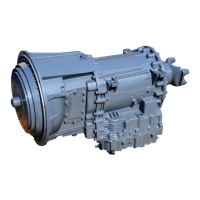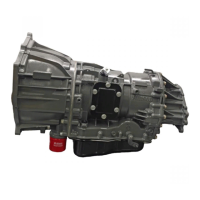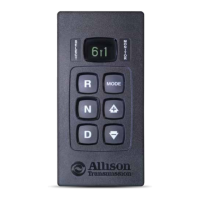If the level is too high, the fluid aerates—causing the transmission to shift
erratically and overheat. Fluid may be expelled through the breather or dipstick
tube when the fluid level is too high.
2–3. TRANSMISSION FLUID TEST
a. Electronic Fluid Test Procedure. Fluid level can be electronically displayed
on a pushbutton (non-strip type) shift selector, lever shift selector, or Allison
DOC™ For PC–Service Tool if there is an oil level sensor (OLS) installed and
“autodetected” by the WTEC III control system. Frequently test for the presence
of oil level diagnostics if the transmission is known to contain an OLS.
If an OLS is not detected during the first 49 engine starts, the WTEC III system
concludes that no OLS is present. If an OLS is known to be present, but has not
been “autodetected”, then troubleshoot the OLS circuit.
After the OLS circuit is repaired, reset “autodetect” or manually select the OLS
function using the Allison DOC™ service tool and then reset autodetect (refer to
TS2973EN, WTEC III Troubleshooting Manual for detailed troubleshooting
procedures).
• Displaying Fluid Level Information. Use the following procedure to display
fluid level information (refer to Figure 2–1).
— For a pushbutton shift selector: Simultaneously press the ↑ (Up) and
↓ (Down) arrow buttons once.
— For a lever shift selector: Press the DISPLAY MODE/DIAGNOSTIC
button once.
— For Allison DOC™ For PC–service tool: Connect the Allison DOC™
For PC–service tool to the diagnostic tool connector on the wiring
harness and scroll down the DIAGNOSTIC DATA LIST to read the
OLS information.
• Fluid Level Display Criteria. As soon as fluid level information is
requested, the ECU determines if conditions are right to allow display.
Certain operating conditions must have been met for a period of two
minutes before fluid level is displayed. These operating conditions are:
— Engine at idle
— Sump fluid at operating temperature 60–104°C (140–220°F)
— Transmission output shaft stopped
— Transmission in neutral
— OLS functioning properly
21

